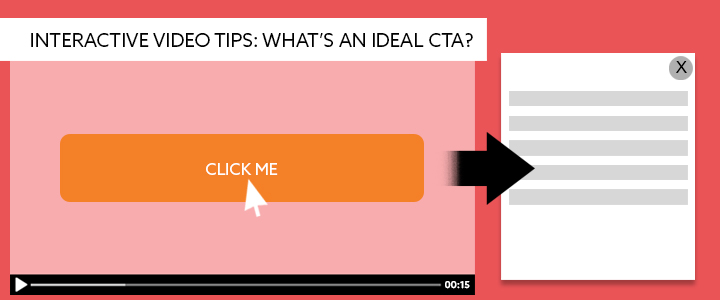
Great video is usually expensive, time-consuming, and generally requires an army of specialized personnel focusing on the many pieces of the puzzle. But where does that leave the bright, creative people regularly posting quality how-to videos, product overviews, “About Us” vignettes, recruiting videos, corporate communications, and video blog content on a budget? How can they compete against expensive, polished production when it comes to capturing viewer attention?
The most obvious answer is in the content. Content marketing has become sophisticated, refined, and effective, poising video as the primary delivery device for that content going forward. But there is one common element that almost all great content marketing has in common that has traditionally been missing from video: the effective call-to-action (CTA).
The ease with which anyone with a smartphone can create, upload, and share video content has opened up the world to a flood of video. To be honest, most of these videos are bad, some are good, and few are great. However, it’s not difficult to turn those “good videos” into “great videos” with the aid of Interactive Video (IV) and properly placed CTAs.
A call-to-action is usually a line of text – or in the case of most online videos, a hyperlink or button that pops up within the video – that urges the viewer to do something. With static videos, marketers can insert CTAs, but they tend to break up the user experience by ending the video or sending the user to another page. With IV, marketers can choose where in the video to put CTAs, effectively offering the viewer the option to click on a product or topic that interests them.
How to effectively incorporate CTAs into video
There are a few large differences between CTAs in written content and CTAs in video: location, frequency, and timing. When crafting a landing page or blog post, the CTA usually appears near the bottom of the page or is associated with one action on the page. Creatively, the format of the page limits the design. With Interactive Video, however, you can leverage the art of storytelling to build suspense and excitement, and then place your CTA at the ideal inflection point.
Imagine an Interactive Video showing two teams summiting a peak in which the viewer is able to choose which team to follow at different points in the story. As the sun rises over the mountain, the voiceover says “only a privileged few will ever get to see this view firsthand.” Then, a CTA pops up on the video saying “Book Your Trip Now.”
Designing a project with subscriber conversion in mind is another effective strategy. The project we built with Gaiam TV, for example, has 27 total CTAs to make subscription accessible from every video node. The user is able to navigate to the content they want while being gracefully prompted to subscribe. As a conversion tool, the video doubled the performance against Gaiam TV’s non-video home page with all other elements being the same.
Strategy for video with CTAs
It’s important to think of a CTA as an invitation and not a hurdle to overcome. As a content producer you don’t want to lock any content behind a CTA. Rather, you should encourage action by offering something of value. Some powerful CTAs are: “Download a PDF of this information,” “Have a representative call me with more information,” “Add this item to my cart,” or “Join now for full access.”
Maybelline’s “Big Eye Beauty Adventure” Interactive Video campaign is a great example of how offering smartly placed CTAs can lead to successful click-through-rates. Maybelline was looking to educate consumers about beauty products and trends in application, engage those consumers for sustained periods, and convert that engagement into product sales.
Maybelline created an interactive beauty adventure where viewers have the unique ability to click the video to choose which signature makeup looks they want to learn about and then buy the featured products after. The IV experience encompassed multiple product and commerce CTAs and averaged a 5 percent click-through-rate – more than what non-interactive video projects see.
Using strategically placed CTAs in Interactive Videos allows content creators to reach their audiences in a more effective way than ever before. It’s time for the producers of “good video” around the world to embrace the creative flexibility of Interactive Video to change the way video is produced, and make this traditionally passive medium an active, participatory experience.
Have any questions about Interactive Video you’d like answered? Drop them in the comments below and we’ll add them to our list of IV Tips. See you next week!
Missed last week’s IV Tips? Check it out here: How to create and leverage menu-driven IVs [Week 3].






